
Houseplants are usually favored for their leaves. From the ever-popular Monstera deliciousa to the collectible Pepperomia varieties, social media feeds are filled with foliage.
But that’s not the only thing to love about houseplants – many of them flower too.
It’s not easy for plants to produce flowers. Their stunning colors, shapes and textures come from hard work on the plant’s part. This hard work is only possible with energy, and plenty of it, provided from the sun. With less light indoors, it therefore makes sense that fewer plants flower indoors.
However, there are many plants that will produce stunning flowers without the hours of direct sun most other flowering plants need.
With some bright indirect light and the right care, these plants will flower year after year. And as a bonus, because they are indoors, they may even flower all year round.
1. Peace Lily
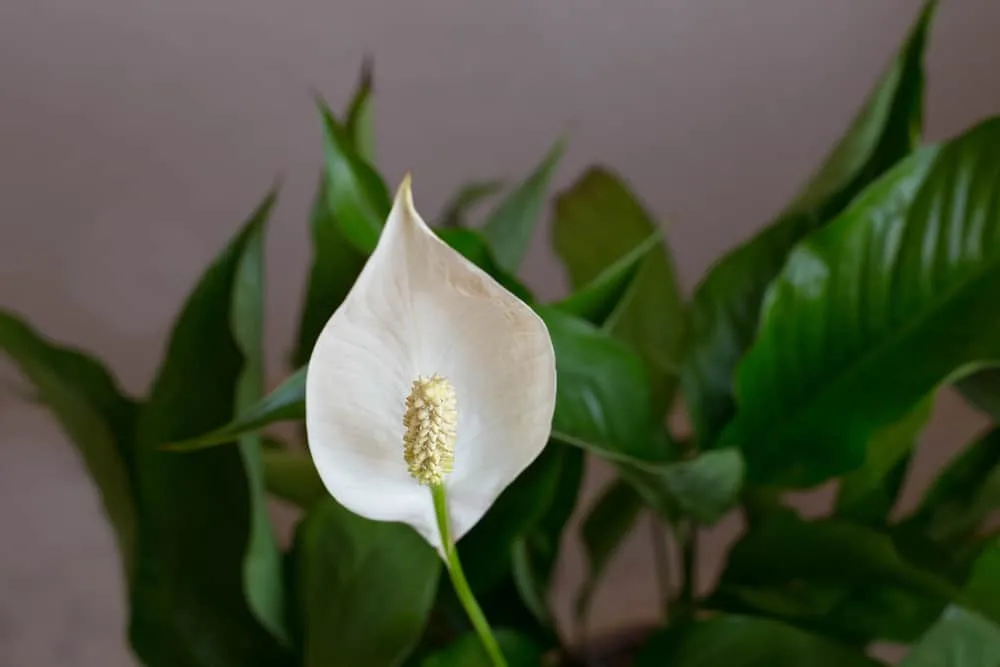
Every houseplant lover will have at least one Spathiphyllum in their home. If not, you’ve certainly seen this plant somewhere in your grandmother’s house.
An indoor garden staple, the Peace Lily is loved for its tolerance of low light conditions and its deep green shiny leaves.
This plant produces elegant white flowers (technically leaves) with a tropical look guaranteed to wow. It flowers year-round, but produces most flowers in the peak summer growing period.
It will produce more flowers in bright, indirect light, but is one of the few flowering plants that will still produce blooms in lower light conditions.
Related Reading: 7 Reasons Your Peace Lily Leaves Are Turning Yellow
2. African Violet
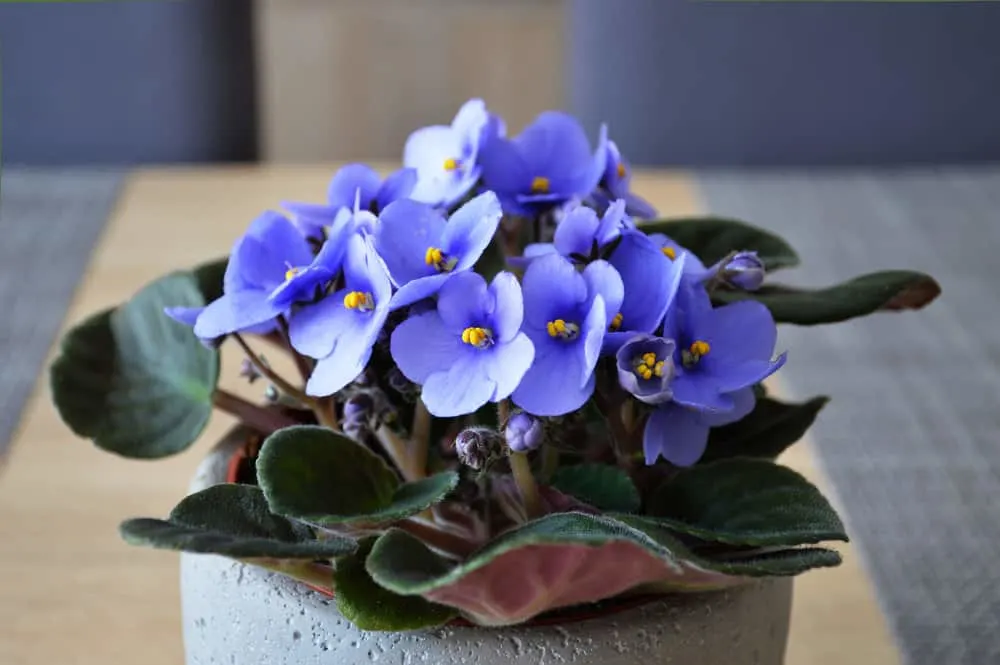
When mentioning flowering houseplants, African violets always come to mind. Their quintessential grey-green leaves and stunning purple-blue flowers are hard to miss. But what gardeners love most about this plant is its ability to flower reliably, despite a little neglect or a missed watering here and there.
An old favorite, this compact plant is best grown in bright indirect light. But, like the peace lily, it can handle a bit less and still flower.
In the right conditions, your African violet will flower several times a year, or may even stay in flower for the entire year.
Always water the soil directly and never the leaves. The small hairs that give the plant its fuzzy grey appearance trap water easily, causing the leaves to become discolored.
3. Hoya
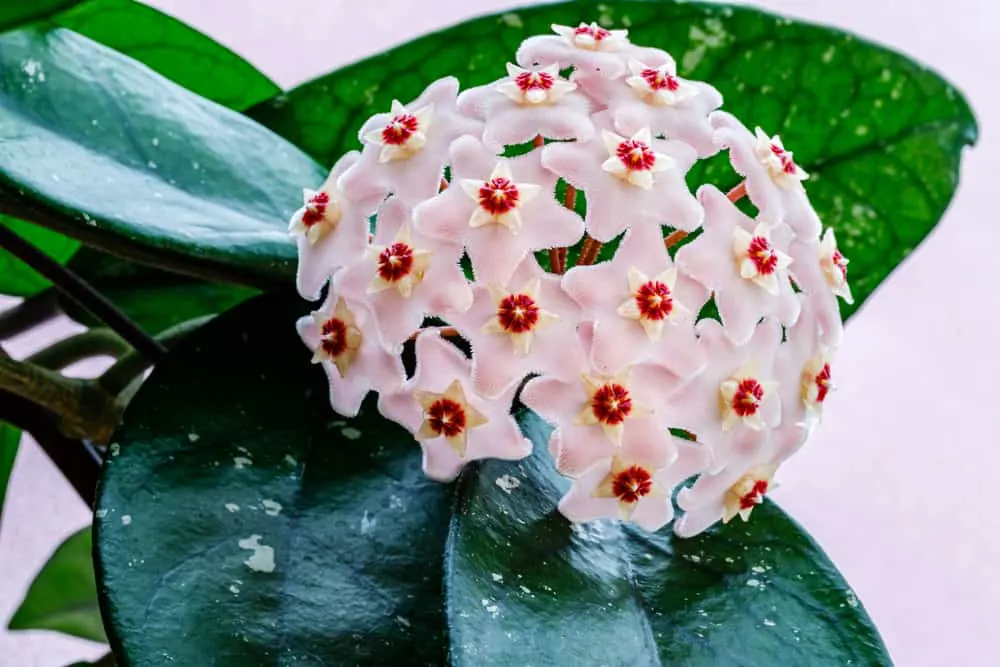
You may be surprised to see the popular hoya on this list. These plants are known for their stand-out foliage – waxy, thick leaves in a range of colors and variegation patterns. However, given the right conditions, these leafy plants will flower too, displaying trails of delicate bunched blooms.
Hoya’s grow well in a range of conditions. With their juicy leaves that store plenty of water, they can also survive long periods without any care. In fact, they do better with too little water than with too much water.
But, if you want your hoya to flower, ensure it is placed in a high light area right near a window and avoid overwatering.
4. Anthurium
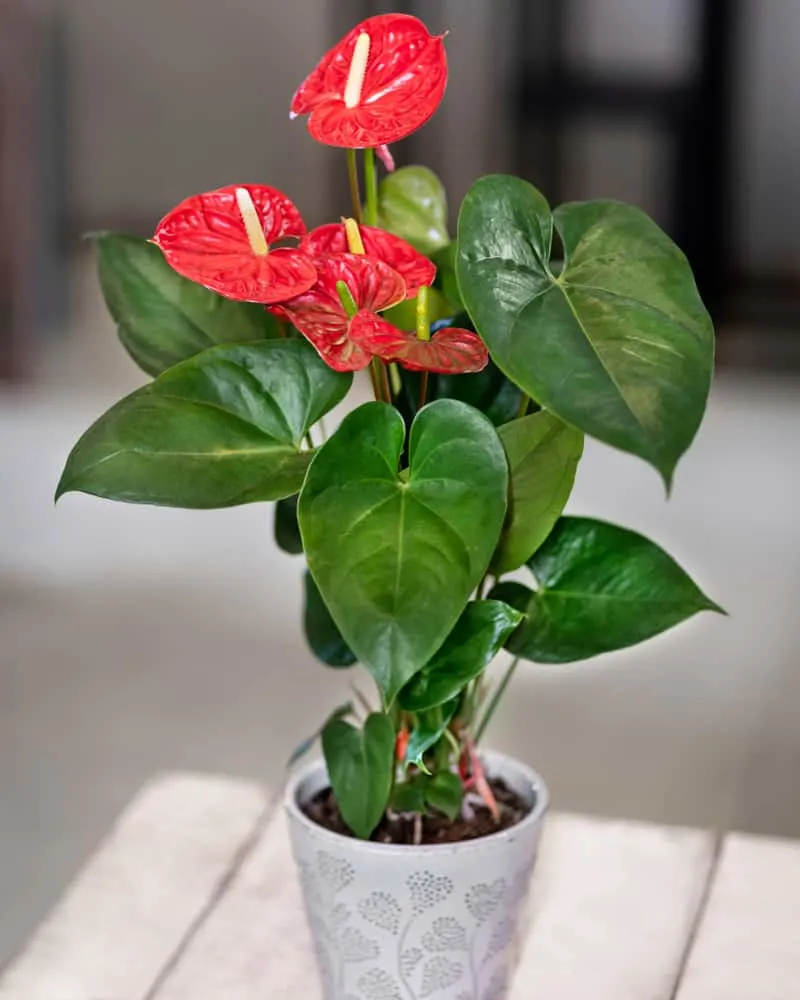
The anthurium is another houseplant you must have encountered at your grandmother’s house. These traditional houseplants have burst back into fashion.
Their range of colors and textures is unmatched, from deep purples to dusty pink and even a mix of pink, white and green aptly known as the Watermelon anthurium.
What many people mistake for the flowers of this plant are actually modified leaves. Looking closely, you’ll see these intricate leaves look closer in thickness and texture to a leaf than to any other flower. This modified leaf curls around a flower spike that gives the plant its classic look.
They may not technically be flowers, but the range of colors they come in certainly makes them look like it, earning them a spot on this list.
5. Hibiscus
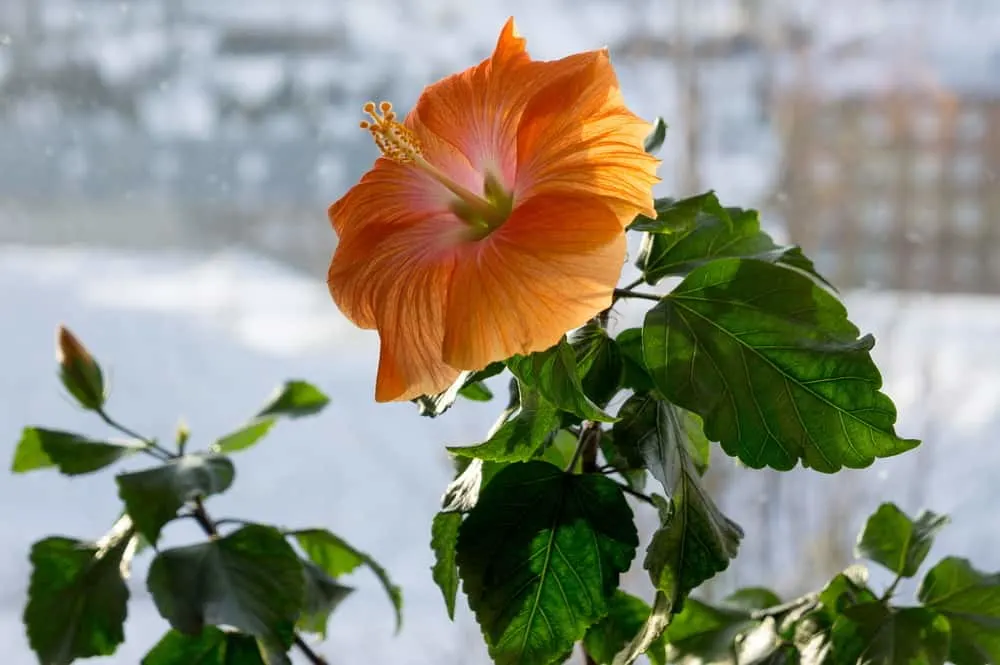
Fans of the tropics will instantly fall in love with this plant. Hibiscus flowers are undoubtedly the star of the show here, having no fights with foliage for attention.
The tropical blooms come in many captivating colors, from bright orange to deep red, or a mix of them all in one flower. If you don’t have a way to watch the sunset from your window, placing a Hibiscus in front of it will make it feel like you can.
If you’re looking for a Hibiscus to grow indoors, always opt for a Tropical Hibiscus, also known as Chinese Hibiscus. These plants are used to tropical conditions and will grow well indoors, as opposed to their relatives Rose of Sharon or Dinnerplate Hibiscus that grow best outdoors.
These plants will need some direct sunlight to flower reliably. Due to their height, they can be placed standing in front of a window to receive a few hours of direct light and mostly indirect bright light for the rest of the day. And, as an added bonus, the flowers are completely edible too.
6. Poinsettia
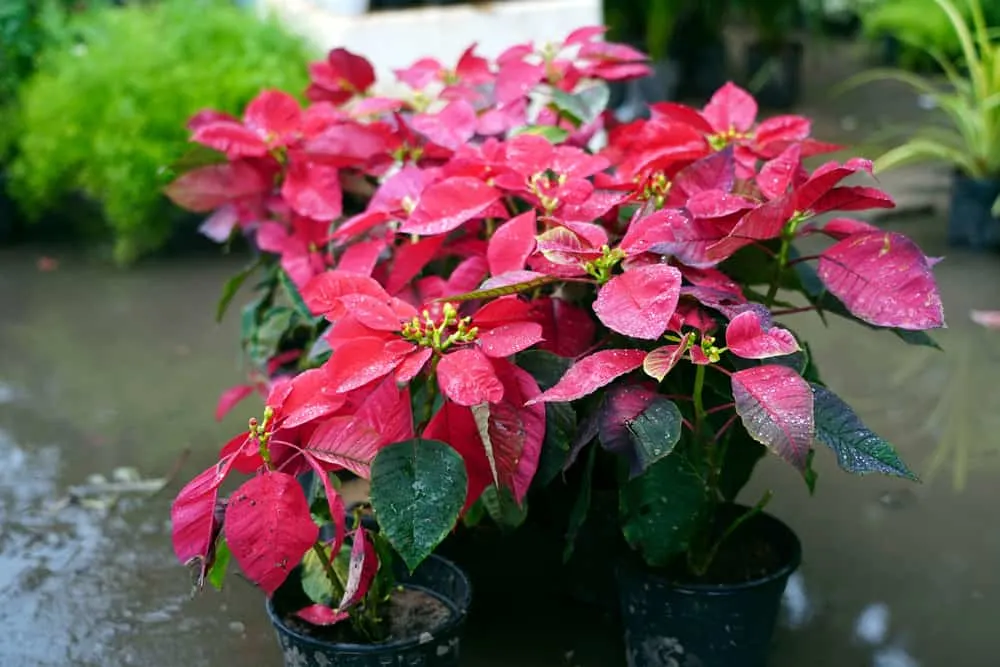
During the holiday season, you’re bound to find hundreds of poinsettias lining the indoor plant section of your local nursery.
While the red variety is known for its Christmas cheer, there are many other poinsettia color options that complement a home all year. Some are even multicolored or display wonderful patterns and textures that light up any space they are placed in.
Like the peace lily, what we consider the poinsettia flower is not actually a flower at all. The colorful parts of the plant are called bracts, surrounding much smaller leaves that form in the center of the plant. But, as they aren’t labeled flowers and grow as a type of leaf, you’re guaranteed more color for longer, without the high light requirements.
7. Christmas Cactus
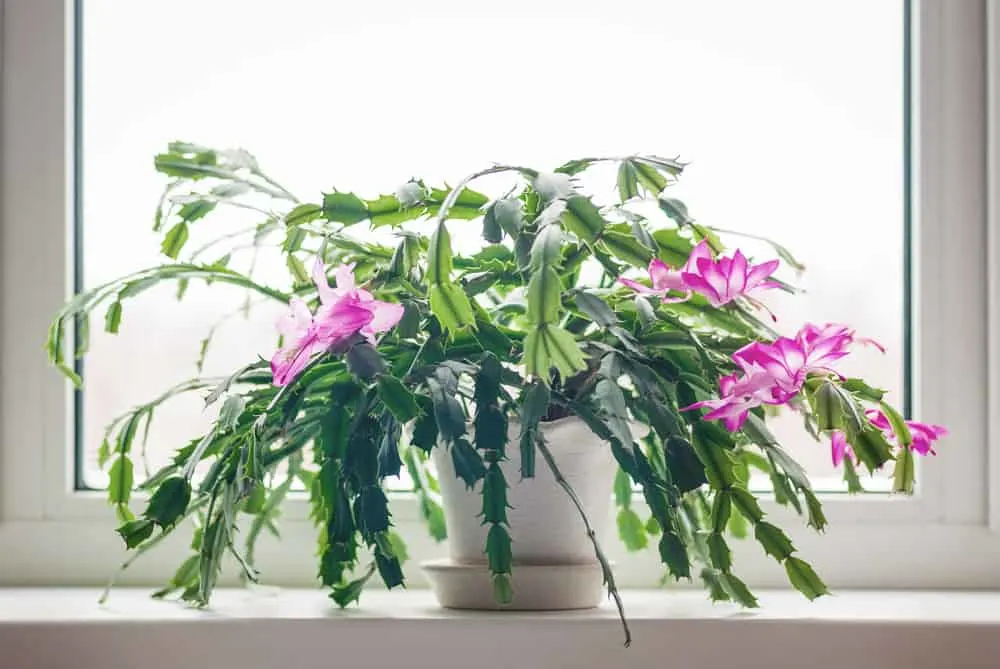
Another holiday plant, the Christmas cactus is beloved for its delicate pink blooms on long, green cactus-like leaves.
Diverging from most flowering plants, the Christmas cactus flowers after being triggered by cold weather, producing blooms over autumn and winter. If you’re looking to brighten up a gloomy winter day, this is the way to do it.
To witness its blooms, you’ll need to place this plant in a high-light area. Despite the cactus in their name, the watering requirements are nothing like a succulent plant, preferring a good watering along with your other tropical foliage plants.
If your plant is not flowering or producing buds at all, place it in a cool, dark place for most of the day. This will replicate the conditions of flowering time for this plant, forcing it to produce blooms. Here’s a cool guide to get more blooms from your Christmas cactus.
8. Orchid
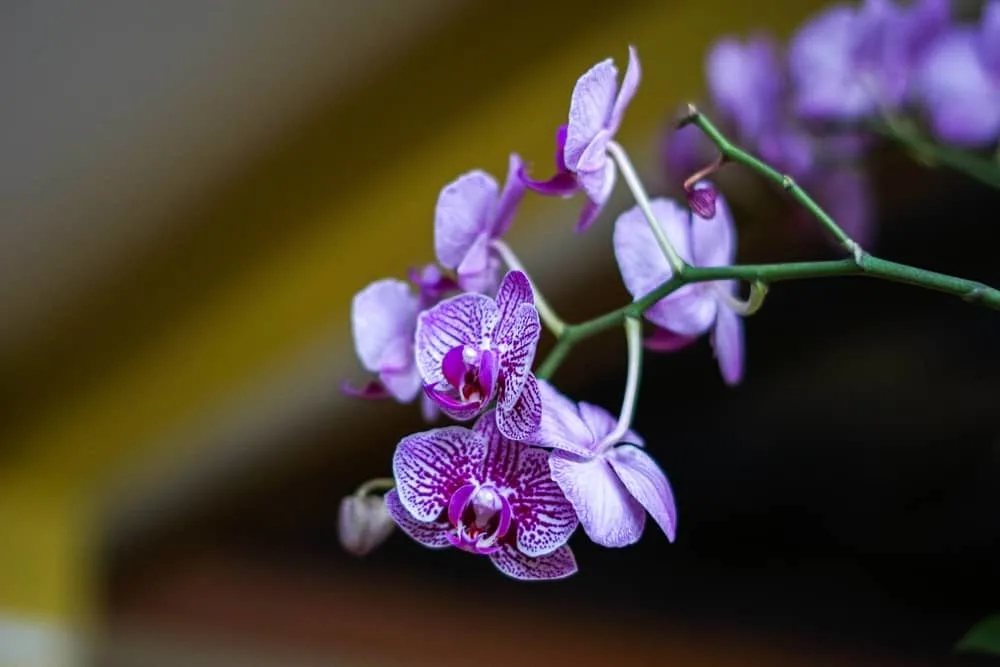
A flowering houseplant list would be incomplete without the addition of the orchid. Whether you choose a Cymbidium or the classic Phalaenopsis, you’ll receive long stalks of intricate blooms in any color you could imagine.
These tropical plants are certainly a collector’s item and have a dedicated following across the world.
As they are quite different from the other easy-to-care-for houseplants we know, they can be tricky to maintain. In the wild, orchids are normally found growing on trees – they are usually considered epiphytes. This means they need incredibly well-draining ‘soil’ usually consisting of a mixture of bark and moss, and a heavy watering every so often, leaving the plant to dry out completely in between.
How to get orchids to flower again is the most common question when it comes to orchid care. Pruning, fertilizing, and a good amount of light are key to getting this plant to shoot up flower stalks season after season.
9. Bromeliad
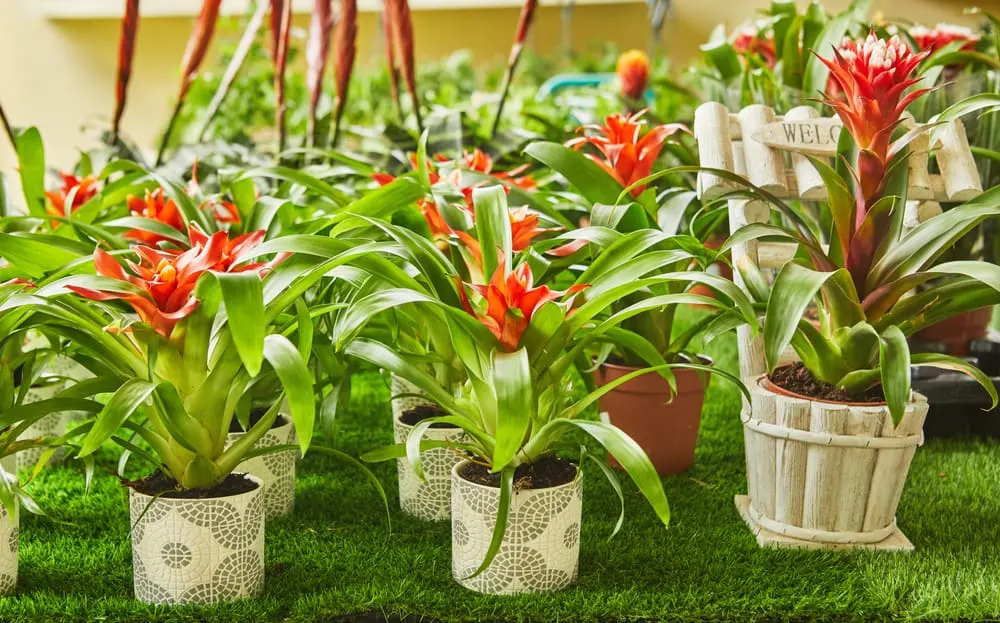
To round off this list, we have a final flowering plant that doesn’t technically ‘flower’.
The shape and texture of bromeliads differ from most houseplants, and from the other plants on this list. The leaves are pointed and structural, and the flowers (also bracts) are spiked. The flowers, on central stems, feature a kaleidoscope of tropical colors, mainly in red, orange and yellow.
Related to the pineapple, this plant has an exotic and tropical look. Place it in bright light and it will dazzle with color for months on end. For an added color contrast, choose a bromeliad with variegated leaves to provide interest from the foliage and the blooms.
With direct sunlight, many flowering plants will bloom indoors. However, they aren’t likely to thrive, and getting them to continue flowering is often a struggle.
If you’re looking to move away from foliage in your home, these nine plants are the way to do it. They will continue to flower without direct light and add a spot of color to any empty indoor corners.
